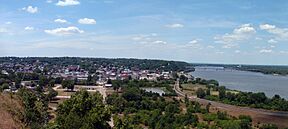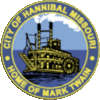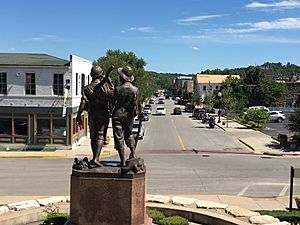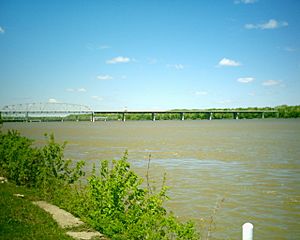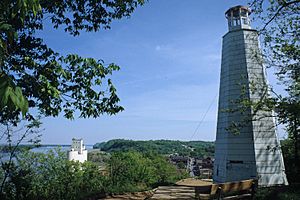Hannibal, Missouri facts for kids
Quick facts for kids
Hannibal, Missouri
|
|||
|---|---|---|---|
|
Downtown Hannibal and the Mississippi River viewed from Lover's Leap
Hannibal–LaGrange University
|
|||
|
|||
| Nickname(s):
America's Hometown
|
|||
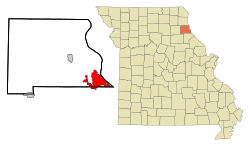
Location within Marion County (left) and Missouri (right)
|
|||
| Country | United States | ||
| State | Missouri | ||
| Counties | Marion, Ralls | ||
| Platted | 1819 | ||
| Incorporated | 1845 | ||
| Government | |||
| • Type | City manager and council | ||
| Area | |||
| • Total | 16.47 sq mi (42.66 km2) | ||
| • Land | 16.00 sq mi (41.44 km2) | ||
| • Water | 0.47 sq mi (1.21 km2) | ||
| Elevation | 646 ft (197 m) | ||
| Population
(2020)
|
|||
| • Total | 17,108 | ||
| • Estimate
(2022)
|
16,938 | ||
| • Density | 1,058.5/sq mi (408.7/km2) | ||
| Time zone | UTC-6 (CST) | ||
| • Summer (DST) | UTC-5 (CDT) | ||
| ZIP code |
63401
|
||
| Area code | 573 | ||
| FIPS code | 29-30214 | ||
| GNIS feature ID | 2394287 | ||
Hannibal is a city in Missouri, located right along the Mississippi River. It's mostly in Marion County, with a small part in Ralls County. In 2020, about 17,312 people lived here.
Hannibal is known as "America's Hometown." It has always been an important place for trade and travel. This is because of its location on the Mississippi River, and its connections by train and highways. Today, major roads like Interstate 72 and U.S. Routes 24, 36, and 61 pass through the city. Hannibal is about 110 miles (177 km) northwest of St. Louis.
Even though Hannibal is a big city, it's not the main county seat for Marion County. That's Palmyra, which is more in the center of the county. Hannibal is the main city in its local area, which includes both Marion and Ralls counties.
Contents
History and Famous Places
Long ago, different groups of Native American tribes lived where Hannibal is now. You can still see ancient burial mounds at Osterhout Mounds Park.
Hannibal is famous because it was the childhood home of the writer Samuel Langhorne Clemens. You might know him better by his pen name, Mark Twain. He lived here from 1835 to 1910. Twain used his childhood memories of Hannibal to write his famous books, The Adventures of Tom Sawyer and Adventures of Huckleberry Finn. Many places in Hannibal are connected to Mark Twain and his stories.
People from all over the world visit Hannibal because of its history, especially the Mark Twain sites. This "heritage tourism" helps the city's economy. The Mark Twain Boyhood Home & Museum has been open for over 100 years. It has welcomed visitors from every U.S. state and about 60 different countries!
How Hannibal Grew
After the United States bought the Louisiana Territory in 1803, settlers from Europe started moving into the area. The first European settlements were built by French colonists.
Hannibal was planned out in 1819 by Moses Bates. He named it after Hannibal Creek, which was later called Bear Creek. The name "Hannibal" comes from a famous hero from ancient Carthage.
The city grew slowly at first. By 1830, only 30 people lived there. But by 1846, Hannibal was Missouri's third-largest city. This was when the Hannibal and St. Joseph Railroad was started. Mark Twain's father, John M. Clemens, helped organize this railroad. It connected Hannibal to St. Joseph, Missouri in the west. This railroad was the farthest west train line before the Transcontinental Railroad was built. It even carried mail for the first Pony Express outpost.
More railroads and steamboats on the Mississippi River helped Hannibal grow a lot. In 1843, the city also added the town of South Hannibal. Hannibal officially became a "city" in 1845. By 1850, it had 2,020 residents.
In the late 1800s and early 1900s, Hannibal became a center for selling farm animals and crops. It also produced things like cement and shoes. The cement used for famous buildings like the Empire State Building and the Panama Canal was made nearby.
The Mark Twain Memorial Lighthouse was built in 1933. It has been lit up three times for special events by U.S. Presidents. Rockcliffe Mansion, a beautiful old house in Hannibal, is listed on the National Register of Historic Places.
In 2011, the Mark Twain Boyhood Home and Museum released a music CD. It featured famous entertainers telling Mark Twain's life story through words and songs. Some songs were written just for this project and mention Hannibal.
Geography and Climate
Hannibal is on the west side of the Mississippi River. It is located across the river from East Hannibal, Illinois. The next big city north is Quincy, Illinois, about 17 miles (27 km) away. The next city south is Louisiana, Missouri, about 25 miles (40 km) away.
Hannibal covers a total area of about 16.47 square miles (42.66 km2). Most of this area is land, with a small part being water.
Hannibal's Weather
Hannibal has a climate with cold, snowy winters and hot, humid summers. The average temperature is below freezing for three months of the year. It's usually above 50°F (10°C) for seven months, and above 72°F (22°C) for three months.
| Climate data for Hannibal Water Works, Missouri (1991–2020 normals, extremes 1902–present) | |||||||||||||
|---|---|---|---|---|---|---|---|---|---|---|---|---|---|
| Month | Jan | Feb | Mar | Apr | May | Jun | Jul | Aug | Sep | Oct | Nov | Dec | Year |
| Record high °F (°C) | 77 (25) |
81 (27) |
91 (33) |
93 (34) |
104 (40) |
104 (40) |
114 (46) |
110 (43) |
102 (39) |
95 (35) |
83 (28) |
74 (23) |
114 (46) |
| Mean daily maximum °F (°C) | 34.6 (1.4) |
39.6 (4.2) |
51.4 (10.8) |
63.7 (17.6) |
73.3 (22.9) |
82.1 (27.8) |
85.7 (29.8) |
84.4 (29.1) |
77.9 (25.5) |
65.7 (18.7) |
51.5 (10.8) |
39.3 (4.1) |
62.4 (16.9) |
| Daily mean °F (°C) | 26.3 (−3.2) |
30.6 (−0.8) |
41.7 (5.4) |
53.2 (11.8) |
63.6 (17.6) |
72.8 (22.7) |
76.5 (24.7) |
74.8 (23.8) |
67.4 (19.7) |
55.3 (12.9) |
42.5 (5.8) |
31.4 (−0.3) |
53.0 (11.7) |
| Mean daily minimum °F (°C) | 17.9 (−7.8) |
21.6 (−5.8) |
32.0 (0.0) |
42.8 (6.0) |
54.0 (12.2) |
63.5 (17.5) |
67.3 (19.6) |
65.2 (18.4) |
56.9 (13.8) |
44.9 (7.2) |
33.5 (0.8) |
23.4 (−4.8) |
43.6 (6.4) |
| Record low °F (°C) | −21 (−29) |
−25 (−32) |
−9 (−23) |
11 (−12) |
30 (−1) |
43 (6) |
48 (9) |
40 (4) |
30 (−1) |
13 (−11) |
−6 (−21) |
−21 (−29) |
−25 (−32) |
| Average precipitation inches (mm) | 2.11 (54) |
2.25 (57) |
2.76 (70) |
4.33 (110) |
4.96 (126) |
4.91 (125) |
4.11 (104) |
3.92 (100) |
3.53 (90) |
3.39 (86) |
2.82 (72) |
2.19 (56) |
41.28 (1,049) |
| Average precipitation days (≥ 0.01 in) | 8.4 | 7.8 | 9.9 | 11.4 | 12.7 | 10.3 | 8.3 | 8.0 | 7.6 | 9.0 | 8.4 | 8.4 | 110.2 |
| Source: NOAA | |||||||||||||
People of Hannibal
| Historical population | |||
|---|---|---|---|
| Census | Pop. | %± | |
| 1850 | 2,020 | — | |
| 1860 | 6,505 | 222.0% | |
| 1870 | 10,125 | 55.6% | |
| 1880 | 11,074 | 9.4% | |
| 1890 | 12,857 | 16.1% | |
| 1900 | 12,780 | −0.6% | |
| 1910 | 18,341 | 43.5% | |
| 1920 | 19,306 | 5.3% | |
| 1930 | 22,761 | 17.9% | |
| 1940 | 20,865 | −8.3% | |
| 1950 | 20,444 | −2.0% | |
| 1960 | 20,028 | −2.0% | |
| 1970 | 18,609 | −7.1% | |
| 1980 | 18,811 | 1.1% | |
| 1990 | 18,004 | −4.3% | |
| 2000 | 17,757 | −1.4% | |
| 2010 | 17,916 | 0.9% | |
| 2020 | 17,312 | −3.4% | |
| 2022 (est.) | 16,938 | −5.5% | |
| U.S. Decennial Census | |||
In 2020, about 17,108 people lived in Hannibal. Most residents were white (84.81%), and about 7.09% were African American. About 2.4% of the population was Hispanic or Latino.
The average age in Hannibal was 37.3 years old. About 23.5% of the people were under 18. About 18.5% were 65 or older.
Economy and Jobs
Hannibal has a growing community of artists. This is because it's located between the East and West coasts, and homes are affordable.
The General Mills plant in Hannibal was built because the company's founder admired Mark Twain. He wanted to help Twain's hometown.
Major employers in Hannibal include Hannibal Regional Hospital and Hannibal Clinic. Big manufacturers are BASF Chemical Corporation, General Mills, and Watlow Electric Manufacturing Co. The Swiss Colony also has a call center here.
Tourism is a huge part of Hannibal's economy. This is mainly because Samuel Clemens, or Mark Twain, lived here as a boy. He made the town famous in his books. The Mark Twain Boyhood Home & Museum and Mark Twain Cave are two of the city's biggest attractions.
Education in Hannibal
The schools in Hannibal are part of the Hannibal 60 School District.
Hannibal High School opened in 1896. It's a public high school for students from kindergarten through 12th grade.
Hannibal-LaGrange University is a four-year Christian university. It was founded in 1858. The campus moved to Hannibal in 1928.
Moberly Area Community College (MACC-Hannibal) is a two-year college. It was started in 1999.
The Hannibal Free Public Library was the first free public library in the state of Missouri.
Media and News
Hannibal has its own newspaper, the Hannibal Courier-Post. It is printed from Tuesday through Saturday. KHQA is a TV station that serves Hannibal, but its main office is in Quincy, Illinois. Several radio stations are also based in Hannibal, including KGRC 92.9 FM and KHMO 1070 AM.
Getting Around Hannibal
Interstate 72 was extended into Hannibal in 2000. It crosses the Mark Twain Memorial Bridge from Illinois. Interstate 72 connects Hannibal to U.S. Route 61. There are plans to extend Interstate 72 further west. This will connect Hannibal to Kansas City and Springfield. U.S. Route 61 goes from St. Louis in the south all the way to St. Paul, Minnesota. It's known as the Avenue of the Saints corridor.
The Hannibal Regional Airport was renamed William P. Lear Field in 2003. This was to honor Lear, who grew up in Hannibal and invented the Lear Jet. The airport is about 4 miles (6.4 km) west of the city.
Freight railroad tracks connect Hannibal in all directions. Burlington Northern Santa Fe (BNSF) tracks go north and south. Norfolk Southern (NS) tracks go west to Kansas City and east to Illinois.
Famous People from Hannibal
Many notable people have connections to Hannibal:
- Jake Beckley, a major league baseball player.
- Margaret Brown, a passenger on the RMS Titanic, known as "the unsinkable Molly Brown."
- Blanche Bruce, an important politician during the Reconstruction era.
- Marie Ruoff Byrum, the first woman to vote in the United States.
- Cliff Edwards, a singer and actor, famous as the voice of Disney's Jiminy Cricket.
- William P. Lear, the inventor of the car radio and the Lear Jet.
- George Poage, the first African American to win an Olympic medal.
- Mark Twain (Samuel L. Clemens), the famous author.
Things to See and Do
- Cameron Cave (part of the Mark Twain Cave complex)
- Hannibal Rocks Offroad Park
- Jim's Journey: The Huck Finn Freedom Center
- John Garth's Woodside Mansion
- Lover's Leap - A cliff overlooking the Mississippi River. The name comes from a local legend about two Native American lovers.
- Mark Twain Boyhood Home & Museum
- Mark Twain Cave - The cave that inspired Twain's story of Tom and Becky getting lost.
- Mark Twain Memorial Lighthouse - The only lighthouse built inland. It offers amazing views of Hannibal and the Mississippi River. You can climb 244 steps to the top!
- Mark Twain Riverboat
- Molly Brown Birthplace & Museum - The home of the famous RMS Titanic survivor.
- Riverview Park - A large park with wooded land and great views of the river. It has over 3 miles (4.8 km) of trails.
- Rockcliffe Mansion - A beautiful mansion from the early 1900s.
- Sawyer's Creek Fun Park - An amusement area near the river.
- Tom & Becky Appearances - Local 7th-grade children are chosen to play the famous characters, Tom Sawyer and Becky Thatcher. They appear downtown every Saturday and Sunday from March to October.
- Tom Sawyer Days - A fun festival with a fence painting contest, frog jumping contest, mud volleyball, local crafts, and Fourth of July fireworks.
Images for kids
-
The Mississippi River viewed from Cardiff Hill in Hannibal
-
The office of John Clemens, Mark Twain's father, who was the Justice of the Peace
See also
 In Spanish: Hannibal (Misuri) para niños
In Spanish: Hannibal (Misuri) para niños


